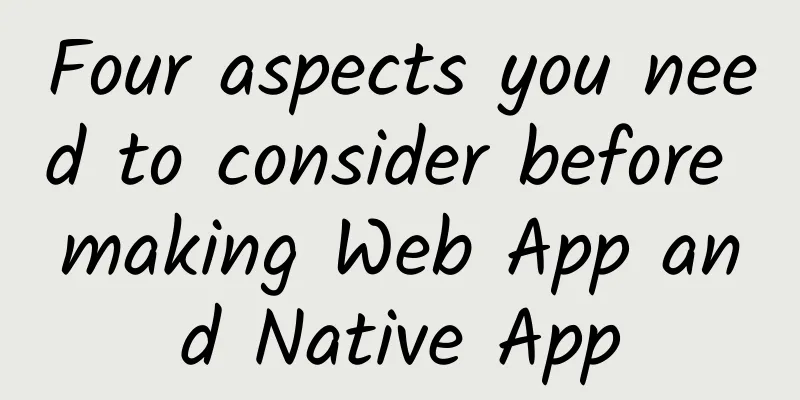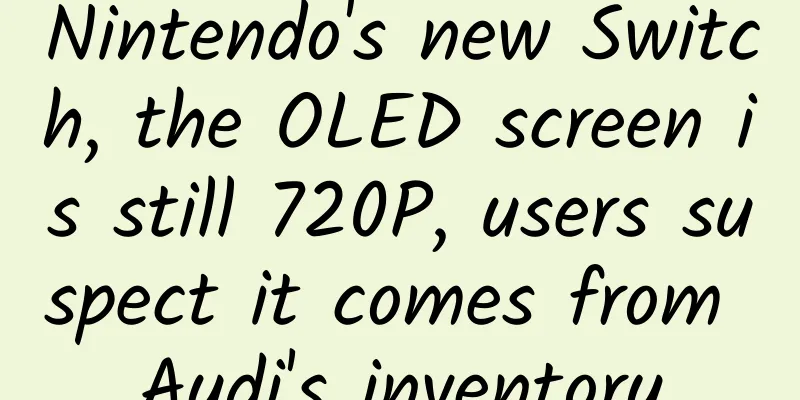Four aspects you need to consider before making Web App and Native App

|
When starting a business, should you choose to develop a native app, or directly use a web app to reach users on WeChat or browsers? Let’s talk about this today. With the update of the fifth edition of HTML (Hypertext Markup Language), which is commonly known as H5, on the mobile side, due to its relatively low development cost and powerful cross-platform operation capabilities, more and more information products have begun to choose such lightweight H5 pages for rapid iteration, while using platforms such as WeChat to quickly reach users. Now that the app bonus period has passed, people are no longer so enthusiastic about downloading apps. In addition, there are so many expensive O2O products that have cultivated user habits. It is difficult to attract users without some subsidies. (Except for very creative or just-needed products) The cost of directly promoting apps in the app market is also very high. For example, in major Android app markets, the price of the homepage banner carousel is 15,000 yuan per day, and the price of the 1st to 4th positions of the popular app vane is 39,000 yuan per day. For products that have not yet received a large amount of financing, these prices are sky-high. At this time, the advantages of the Web are reflected. It is lightweight, iterates quickly, and now there is such a good entrance as WeChat. With 800 million users and the powerful functions of the public platform, it is a waste not to use it~ Therefore, how we choose when it comes to product layout is particularly important. I recently encountered this problem and found a lot of information. I would like to summarize it and share it with you. I also hope that experts who know more can communicate more in the background, I would be very grateful~ Let’s talk about it from four aspects: the advantages and disadvantages of Web compared to App, as well as needs and scenarios. Advantages: H5 can be used across platforms, and the development cost is relatively lower, which can be handled by a product manager + front-end + design + back-end; App needs to be adapted to different platforms such as iOS and Android for design and development, which requires at least iOS engineer + Android engineer + PM + front-end + design + back-end, and the development cost is 1/3 higher or even more. H5 can be updated at any time when it goes online, which is suitable for rapid iteration and has low trial and error costs. Once a function is completed, it can be put online immediately, and there is no pressure to update it dozens of times a day; Apps require users to actively download updates. The mainstream platforms are iOS, Android, and Windows. The operation and promotion methods of different platforms are different, and the distribution and operation and maintenance costs are very high. Moreover, when a version of a function is released, although we can quickly make part of it for internal staff to experience, it may take a week for us to complete it. Then we submit it to the platform for review, wait for a while, and find a good day to release it, and three weeks have passed. At the same time, if we make more new features, optimize details, fix a few bugs, etc., users can only wait for dozens of days to experience it. H5 can reach users in an easy way and provide more convenient services. Compared with downloading a bunch of apps on the desktop, users only need to click on the link on the WeChat portal or browser to get the services we provide. With higher usage time and traffic diversion capabilities, the operation and promotion based on the official account can quickly reach users. Disadvantages: The conversion of H5—>App is highly dependent on the browser. To truly retain users in your product, further conversion is required. However, APP can embed H5, which can be opened directly in the application and converted with H5. Currently, H5 is basically unable to store data locally and relies on real-time data. It will be stuck when the network status is bad. Whenever users need to upload data, such as input, selection, photo upload, etc., page delays will affect the smoothness of use; while APP can store data locally, run faster, save more traffic, and can operate offline or access local resources. H5 performance is relatively low. Even if complex interactions such as 3D special effects, frequent input and output, etc. are implemented, they will reduce the user experience. For example, on a native app, an effect similar to page sliding switching will basically not feel any delay. As long as you start sliding your finger, the page will slide seamlessly. But on the Web, everyone should often see various fancy H5 sharing pages in WeChat, so are the sliding smooth? need: The purpose of any product is to solve a certain need of the user. Regardless of whether this demand already exists or we have discovered it, our products must revolve around meeting user needs. Today's mobile products can be roughly divided into two types. One is tools that help users achieve certain functions, such as various photo-editing apps such as Meitu XiuXiu, various taxi-hailing products, etc.; the other is to satisfy users' information needs, such as food ordering information on Ele.me, various question-and-answer information on Zhihu, etc. That is, functional products and information products. Of course, in many cases a product will have both attributes. So whether it is a Native App or a Web App, we need to consider at least the following three aspects: Core functions of the product First of all, in terms of positioning, it is necessary to clarify what core needs the product solves. Is it to use tools as an entry point to solve a certain pain point and give users a high-quality experience, or to rely on practical or interesting information to allow users to get what they want in the product and then generate awareness of the brand? Accessibility For example, non-core needs such as user communities and services are not the most urgent tasks for users at the moment, and they are flexible in function adjustment and content operation, so they are very suitable to be implemented using web pages. By cooperating with the official account, you can guide users to your own website. At the same time, you can define the services required by users, such as after-sales, rights protection, user community, event entrance, etc. in the custom menu bar, which can better increase user stickiness. Meet operational needs You should be familiar with the various gorgeous H5 sharing in Moments. The more popular ones recently include "Press for a Second", the fun "Anonymous Impression", and the "Art Gallery" of Durex a while ago. This type of phased marketing H5 is quite effective in attracting new product users and operating events. Like "Double 11" and JD.com's "618", not only the version updates for the activities on the App and the page creativity on the H5 site, but the H5 shared exclusively in the circle of friends is also a very important channel. Considering the actual situation of the team, it is very necessary for operations-oriented products to keep up in this regard. Scenario: Where are your users and what problems do they face before they use your product? At home, in the office, outdoors, etc., different application scenarios have a significant impact on user experience. In real scenarios, anything can interrupt the user flow. For example, when commuting to and from work, people will look at their phones on the bus or subway, but they will be interrupted when they reach the station or when there is a large crowd. Users who are waiting in line to buy something may also use their phones, but similarly they will be interrupted at any time. Incoming calls, incoming text messages, push notifications from other apps...these are all factors that distract users. A good user experience should not be affected by these interferences, allowing users to continue to move forward~ Based on the scenario, the product provides the following services to users: Provide users with useful information Taking up users’ fragmented time Segmented services in a certain vertical field And so on…… Only with scenarios can there be experience, and only by focusing on experience can we have a targeted approach. Combined with the pros and cons of H5, it is not difficult to make a choice. After so much nagging, I believe everyone has long wanted to complain. What's the point of tangling? If you can't do both, it's over~ In fact, many teams have adopted both models. First test the new version on the web app, and then quickly collect feedback to guide the update of the Native app, so that the two can complement each other and make team resources more effective. |
<<: Learn more! Five pillars of interaction design that are worth your in-depth understanding
>>: Why You Should Try Full Stack
Recommend
Facial recognition has become a reality. Have you been recognized?
Do you still remember these plots in the movies? ...
Summary of the key Android interview questions
1. Please explain the relationship between Messag...
Analysis of major mainstream information flow promotion channels in 2019!
With the development of social media, information...
A brief discussion on seed user operations before and after product launch!
I have been wanting to talk about the seed user o...
The industry marketing strategy that took 5 years to compile is given to you!
The home improvement industry is at a turning poi...
Today is the day when black technology is booming
[[164892]] It's April Fools' Day again Te...
Can the Apple Watch help human society regain the habit of wearing watches?
On October 7, Apple Watch was released. In an int...
The underlying logic of short video operations!
The power of short videos is 9 times that of long...
Weekly Science | Answers to common questions from parents about children's vision protection
Myopia prevention and control Recently, we have s...
Pain and numbness? Lumbar disc herniation can be relieved with a few simple movements →
Lumbar disc herniation is one of the common "...
Apple held its first conference this year, and Cook revealed some information
On March 1, Apple held its first conference in 20...
World Migratory Bird Day丨This migration journey that concerns survival is more than just magnificent!
When the leaves fall and the flowers turn yellow,...
Windows 10's new start screen revealed: Tile folders are born
Although Windows 10 has been released for more tha...
Landing page conversion is poor? 3 reasons!
The quality of the landing page is related to the...
Join Mi Meng and others to launch a new publication. Let's take a look at how to become a commercial service provider for online content.
For most modern people, there is less and less ti...









